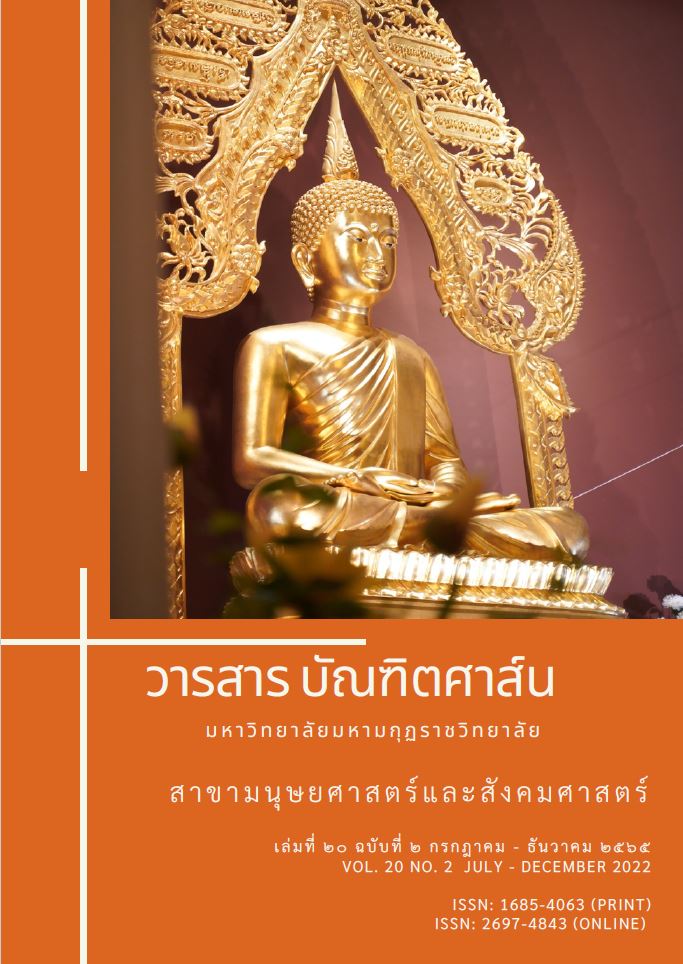การพัฒนาการคิดแบบองค์รวมด้วยหลักธรรมในพระพุทธศาสนา
คำสำคัญ:
การคิดแบบองค์รวม, การพัฒนาการคิดแบบองค์รวมด้วยหลักธรรมในพระพุทธศาสนาบทคัดย่อ
ดุษฎีนิพนธ์นี้ มีวัตถุประสงค์ ดังนี้ 1) เพื่อศึกษาแนวคิดและทฤษฎีเกี่ยวกับการพัฒนาการคิดแบบองค์รวม 2) เพื่อศึกษาหลักธรรมในพระพุทธศาสนาที่เกี่ยวกับการพัฒนาการคิด 3) เพื่อบูรณาการการพัฒนาการคิดแบบองค์รวมด้วยหลักธรรมในพระพุทธศาสนา 4) เพื่อนำเสนอองค์ความรู้เกี่ยวกับการบูรณาการการพัฒนาการคิดแบบองค์รวมด้วยหลักธรรมในพระพุทธศาสนา โดยใช้ระเบียบวิธีวิจัยเชิงคุณภาพแบบวิจัยเอกสาร การวิเคราะห์เชิงพรรณนา และสัมภาษณ์เชิงลึกผู้ทรง คุณวุฒิจำนวน 11 รูป/คน เป็นหลัก
ผลการวิจัยพบว่า
แนวคิดแบบองค์รวมและการคิดแบบองค์รวมอันเป็นกระแสหลักของสังคมโลกยุคปัจจุบันมี 3 แนวคิดหลักได้แก่ ความเป็นทั้งหมดตามนัยปรัชญากรีกโบราณ ตัวแบบเชิงระบบ และจิตวิทยาเก็สตัลท์ ผลกระทบจากการเปลี่ยนแปลงทางวิทยาศาสตร์และเทคโนโลยีสารสนเทศในสังคมโลกยุคฐานวิถีชีวิตใหม่เป็นเหตุปัจจัยที่นำไปสู่ข้อเรียกร้องในการหาวิธีการคิดใหม่ที่เกื้อหนุนให้มนุษย์เป็นกำลังคนคุณภาพผู้เปรื่องปัญญา มีสมรรถนะในการคิดเพื่อสร้างนวัตกรรมและผลผลิตทางการคิดเชิงพาณิชย์ สามารถใช้ประโยชน์จากปัญญาประดิษฐ์และหุ่นยนต์ได้อย่างชาญฉลาด วิธีการคิดที่พึงนำมาใช้ในการพัฒนากำลังคนคุณภาพคือ ลักษณะการคิด 3 ได้แก่ การคิดเชิงเหตุผล การคิดเชิงสร้างสรรค์ การคิดเชิงความเป็นไปได้ กับความสามารถ 3 ได้แก่ ความสามารถในการคิดเชิงสัญลักษณ์ ความสามารถในการคาดคะเน ความสามารถในการทำให้เกิดผลอย่างต่อเนื่อง
ญาณทัสสนะและอริยสัจสี่เป็นหลักธรรมตัวอย่างซึ่งแสดงให้เห็นถึงความเป็นองค์รวมบนฐานของการคิดที่ดีคือ เป็นจริง มีประโยชน์ ปฏิบัติได้ ถูกกาลเทศะ โดยมีหลักธรรมที่เกี่ยวข้องกับการคิดโดยตรงคือ มรรคมีองค์แปดและอัญญาสมานาเจตสิก ส่วนการคิดแบบองค์รวมในพระพุทธศาสนาคือ การหยั่งเห็นภาพรวมของหลักธรรมต่าง ๆ ที่เพียงพอกับการพิจารณาโดยแยบคาย และนำไปสู่ผล 3 ประการได้แก่ ความรู้แจ้งตามความเป็นจริง การแก้ปัญหาให้หมดไปโดยสิ้นเชิง และความเจริญโดยบริบูรณ์ วิธีการพัฒนาการคิดในพระพุทธศาสนามี 2 แนวทางคือ การพัฒนาโดยใช้หลักปรโตโฆะสะ - โยนิโสมนสิการ และการนำเกณฑ์การพิจารณาสัตว์โลกของพระบรมศาสดามาปรับประยุกต์ใช้
การคิดแบบองค์รวมเชิงพุทธเป็นกระบวนทัศน์ที่สร้างความสมดุลให้กับวิธีคิดและผลิตภาพทางการคิดเพื่อตอบสนองความต้องการในสังคมโลกยุคฐานวิถีชีวิตใหม่ สารัตถะแห่งการคิดแบบองค์รวมประกอบด้วยความพรั่งพร้อม ความถึงพร้อม และความเพียงพอกับการดำเนินชีวิตที่ดีของปัจเจกบุคคล โดยใช้ตัวชี้วัด“ปทุมเกณฑ์”เป็นแนวทางการพัฒนาการคิดแบบองค์รวมที่มุ่งเน้นการเสริมสร้างสมรรถนะและทักษะทางจิตที่เอื้อต่อการคิดแบบองค์รวม แล้วสังเคราะห์เป็นความรู้ที่เรียกว่า ผลึกการคิดที่มุ่งสู่ความเจริญโดยบริบูรณ์ (The Buddhist Synergetic Thinking Growth Model)
เอกสารอ้างอิง
จอห์น เมดิน่า. (2560). 12 กฎทองของคนใช้สมองเป็น. (วิโรจน์ ภัทรทีปกร,แปล). กรุงเทพฯ: วีเลิร์น.
จิราภรณ์ ตั้งกิตติภาภรณ์. (2559). จิตวิทยาบุคลิกภาพและพฤติกรรมสุขภาพ. กรุงเทพฯ: สำนักพิมพ์แห่งจุฬา
ลงกรณ์มหาวิทยาลัย.
ธัญญภัสร์ ศิรธัชนราโรจน์. (2561). จิตวิทยากับการพัฒนาตน. พิมพ์ครั้งที่ 3. กรุงเทพฯ: สำนักพิมพ์แห่งจุฬา
ลงกรณ์มหาวิทยาลัย.
พระพรหมคุณาภรณ์ (ป.อ. ปยุตฺโต). (2556). พุทธธรรม ฉบับปรับขยาย. พิมพ์ครั้งที่ 40. กรุงเทพฯ: มูลนิธิ
ธรรมทานกุศลจิต.
มหามกุฎราชวิทยาลัย ในพระบรมราชูปถัมภ์. (2559). พระไตรปิฎกและอรรถกถาแปล ฉบับมหามกุฎ
ราชวิทยาลัย. พิมพ์ครั้งที่ 12. กรุงเทพฯ: มูลนิธิมหามกุฎราชวิทยาลัยฯ.
สุเชาวน์ พลอยชุม. (2555). พุทธศาสนา : ศาสนาหรือปรัชญา, ใน สุเชาวน์ พลอยชุม และ สุวิญ รักสัตย์.
สารัตถะวิชาการพุทธปรัชญา. (หน้า 1 – 13). นครปฐม: บัณฑิตวิทยาลัย มหาวิทยาลัยมหามกุฎ
ราชวิทยาลัย
โรวาน กิ๊บสัน. (2546). คิดใหม่ต่อธุรกิจ. ใน โรวาน กิ๊บสัน (บรรณาธิการ). คิดใหม่เพื่ออนาคต. (หน้า 13 - 29). (ธันยวัชร์ ไชยตระกูลชัย แปล). กรุงเทพฯ: ผู้จัดการ.
เอ็ดเวิร์ด เดอโบโน. (2556). สุดยอดทักษะการคิด. (กานต์สุดา มาฆะศิรานนท์, แปล). กรุงเทพฯ:
แอคทีฟพริ้นท์
Saul McLeod. (2019). Likert Scale Definition, Examples and Analysis. from https://www.
simplypsychology.org/likert-scale.html
ดาวน์โหลด
เผยแพร่แล้ว
รูปแบบการอ้างอิง
ฉบับ
ประเภทบทความ
สัญญาอนุญาต
ลิขสิทธิ์ (c) 2022 มหาวิทยาลัยมหามกุฏราชวิทยาลัย

อนุญาตภายใต้เงื่อนไข Creative Commons Attribution-NonCommercial-NoDerivatives 4.0 International License.
บทความวิชาการและบทความวิจัยในวารสารฉบับนี้ถือเป็นความรับผิดชอบของผู้เขียนเท่านั้น บทความที่ได้รับการตีพิมพ์ในวารสารบัณฑิตศาส์น ถือเป็นลิขสิทธิ์ของมหาวิทยาลัยมหามกุฏราชวิทยาลัย ตามพระราชบัญญัติลิขสิทธิ์



